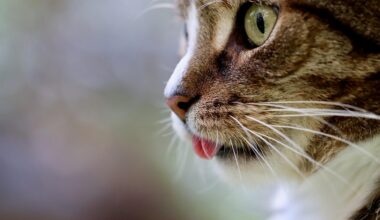Case Studies on Legal Disputes Between Cat Owners and Wildlife Authorities
As urban expansion continues, the interaction between cats and local wildlife becomes a subject of legal debate. Numerous disputes arise between cat owners, who often wish to allow their pets to roam freely, and wildlife authorities dedicated to protecting endangered species. One notable case involved a neighborhood cat that frequently hunted birds in a protected area. Wildlife protection laws based on the Migratory Bird Treaty Act resulted in a citation against the cat’s owner. Legal battles ensued, forcing judges to weigh property rights against wildlife conservation measures. Lawmakers have also responded, seeking ways to balance cat ownership with wildlife protection. Mediation has become a frequently suggested solution as conflicts intensify. Case outcomes can vary significantly, depending on local ordinances and the precise nature of each incident. Cat advocacy groups are often pitted against environmental organizations, adding complexity to case resolutions. Consequently, the outcomes can set precedents for future cases, influencing wildlife and pet ownership legislation. In many areas, cat owners are now required to adhere to specific restrictions regarding their pets, aiming to limit interactions with local wildlife. The debate continues as both sides advocate fiercely for their interests.
Legal information is essential for case studies involving cats and wildlife disputes. Many states have adopted laws governing the treatment of cats, which can directly conflict with wildlife regulations. Often, law enforcement agencies find themselves in complicated positions, having to navigate both sets of laws effectively. In one striking example, a cat was impounded after repeatedly trespassing in a wildlife sanctuary. The owner argued that the cat should be allowed to roam, citing its natural instincts. Authorities countered that any animal in a protected area risks endangering native species. The owner launched a lawsuit, claiming violation of personal freedoms and the right to pet ownership. In this case study, both sides presented robust arguments, prompting a legal examination of wildlife laws and pet ownership. This scenario illustrates the ongoing tension between individual rights and communal environmental responsibility. Most cat owners believe they can manage their pets effectively without impacting wildlife. A campaign has emerged, promoting responsible cat ownership, including leash walking and indoor alternatives. Advocates encourage taking stringent measures to prevent feline predation on wildlife. Educating the public about both the joys of cat ownership and the necessity of wildlife protection is vital to fostering respect among both communities.
In recent years, non-compete laws have emerged within wildlife protection discussions regarding cat ownership. One high-profile case involved a local community attempting to restrain cat populations to protect native species. Felines could be captured and relocated, or owners would face fines. The cat owners rallied, claiming that such measures violated their rights. This generated widespread media coverage, drawing attention to the controversy over animal rights within conservation laws. Local authorities justified their actions by citing data demonstrating a significant decrease in bird populations due to free-roaming cats. An environmental study indicated that neighborhoods restricting cat movement reported increased biodiversity. Legal challenges arose as cat lovers and wildlife officials argued over the ethics of such locations. Each side accrued supporters, reinforcing their positions using scientific evidence and emotional appeals. Eventually, a compromise was achieved, addressing both parties’ needs. Pet owners agreed to keep their cats indoors, while authorities promised to provide resources for responsible pet care. This agreement highlighted the necessity of dialogue between differing stakeholders in animal welfare and wildlife preservation. Cooperative efforts may become essential to ensure coexistence, as the pressures of urbanization challenge existing wildlife populations.
Educational Programs and Community Involvement
Engaging the community in educational programs frequently emerges as a positive step in wildlife protection laws affecting cats. Workshops are held to teach cat owners about the impact of their pets on local wildlife. These programs often emphasize the importance of keeping cats indoors, highlighting alternatives that can satisfy a cat’s needs while protecting vulnerable species. For example, local wildlife organizations have collaborated with veterinarians to host events where cat owners can learn about wildlife-friendly practices. One initiative included building catios, which are enclosed outdoor spaces for cats to enjoy the outside without hunting wildlife. In addition, the establishment of community cat programs has helped reduce feral cat populations in humane manners. Volunteers often assist with feeding and monitoring these cat colonies, reducing the potential negative impacts on local wildlife. With proper education and support, communities can find ways to coexist, ensuring that both cats and wildlife thrive together. Partnerships among local governments, wildlife agencies, and feline advocates can yield significant progress in resolving disputes. Implementing educational outreach fosters a more comprehensive understanding of the delicate balance between wildlife conservation and responsible pet ownership, leading to mutually beneficial solutions.
The legal ramifications of wildlife protection laws significantly affect the ownership of cats and often lead to disputes. One important issue involves the enforcement of leash laws for pet cats in conservation areas. In various locations, these cases have sparked debates over the effectiveness and ethics of leashing pets normally deemed free-roaming. A specific incident in a local community revealed a cat owner facing penalties for their pet being seen on a nature reserve without a leash. Critics argue that such regulations infringe upon personal freedoms on private property. Supporters of leash laws claim that they are essential for protecting wildlife and maintaining ecological balance. Consideration of local biodiversity sheds light on this contentious subject. Multiple studies reveal that the presence of unrestrained cats in urban areas can drastically reduce certain bird species’ populations. Consequently, these arguments fuel the necessity for protocols balancing wildlife preservation. Collaborative discussions aimed at creating laws fair to pet owners and efficient for conservation have become necessary. Stakeholders include city officials, animal welfare groups, and community members. Striking a balance is challenging but essential for cultivating an environment that respects both pet ownership and wildlife protection.
Disputes occasionally arise during seasonal wildlife migrations, which significantly impact the enforcement of wildlife protection laws concerning cats. During these periods, concerns heighten regarding free-roaming cats affecting vulnerable migratory species. In one instance, a concerned citizen labeled a neighbor’s cat a menace, claiming it disrupted nests belonging to an endangered bird species. The escalating tensions resulted in a formal complaint to local wildlife authorities. Various outcomes emerged, with some authorities advocating for strict enforcement of wildlife protection ordinances. Others sought a mediation approach that allowed cat owners some leniency. Reviewing these responses shines light on the complexities inherent in ensuring effective legal jurisdiction for protecting wildlife while considering public sentiment regarding pet ownership rights. By analyzing these instances, a clearer understanding of local attitudes toward cats and wildlife interactions can be developed. Finding resolutions that satisfy conflicting interests remains essential to fostering good relationships within communities. Community engagement and public discussion aid in mitigating future disputes. As wildlife laws evolve to accommodate the ongoing concerns of protection and pet ownership, case studies such as this will continue to aid in shaping them effectively.
The Role of Advocacy Groups
Advocacy groups play a crucial role in navigating the challenges posed by wildlife protection laws affecting cats. Many organizations promote the interests of both cat owners and wildlife advocates. For instance, cat advocacy groups educate pet owners on responsible practices that prevent harm to wildlife. They often campaign for understanding, hoping to curb human-animal conflicts. These organizations provide resources for implementing such practices. On the other hand, wildlife protection groups raise awareness about the detrimental effects outdoor cats have on local ecosystems. This often leads to policy changes that could ultimately impact cat ownership regulations. When disputes arise, advocacy groups frequently act as intermediaries, facilitating discussions between opposing parties. They aim to identify common ground and propose solutions that benefit everyone involved. Overall, their participation has the potential to bridge the gap between conservation efforts and pet ownership rights. Collaboration is essential in creating a balanced legal framework that supports sustainable relationships between cats and wildlife. Through shared educational efforts, these organizations can foster a culture of coexistence, emphasizing the responsibilities of pet ownership while promoting safe and healthy environments for local wildlife.
As the legal landscape concerning cats and wildlife evolves, reflecting on lessons learned from prior disputes is vital. This understanding can guide future legislation and advocacy efforts. Emerging divides between cat owners and wildlife advocates often call for innovative solutions to bridge their conflicting interests. Many case studies have demonstrated that disputes can lead to productive outcomes when parties are willing to engage in open dialogue. Collaborating on educational programs regarding responsible pet ownership can promote cooperation. Furthermore, addressing public concerns through discussions helps build trust and understanding between communities. This progressive approach enables effective implementation of wildlife protection laws that prioritize conservation while respecting personal freedoms associated with ownership. Experiences from past conflicts shape future dialogues between stakeholders. Enduring partnerships can forge pathways to solutions that acknowledge the importance of both protecting wildlife and maintaining healthy relationships with pet owners. By utilizing a holistic approach to wildlife activism and animal advocacy, communities can embrace balanced policies that benefit all parties involved. To conclude, understanding these complex interactions will ultimately enhance the quality of life for both pets and local wildlife in a harmonious manner.


